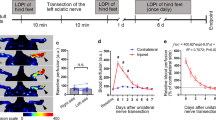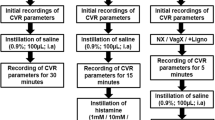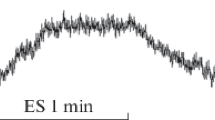Abstract
Antidromic stimulation of the lumbosacral dorsal roots of the rat 1.) evokes a long-lasting increase in cutaneous microcirculation of the paw as detected by the laser Doppler flowmeter, and 2.) induces plasma extravasation in the innervated skin areas and various pelvic organs. Both responses are strongly inhibited or abolished by systemic or local capsaicin desensitization. Cutaneous vasodilatation is evoked already by 1–2 pulses. Desensitization of the volar skin of the forearm abolishes the flare reaction both in the “afferent” and “efferent” side of the axon reflex. A dual sensory-efferent function for capsaicin-sensitive nociceptors is suggested. This local neuroregulatory mechanism mediates neurogenic inflammation, cutaneous vasodilatation and flare reaction not only when the receptors are activated by antidromic stimuli, but also when their orthodromic excitation by chemical means occurs.
Similar content being viewed by others
References
W. M. Bayliss,The Vaso-motor system, Longmans Green, London 1923.
S. H. Buck and T. F. Burks,Neuropharmacology of capsaicin: review of some recent observations, Pharmac. Rev.38, 179–226 (1986).
S. Carpenter and B. Lynn,Abolition of axon reflex flare in human skin by capsaicin, J. Physiol.310, 69–70 (1980).
J. E. Bernstein, M. Swift, S. Keyoumars and A. L. Lorincz,Inhibition of axon reflex vasodilatation by topically applied capsaicin, J. Invest. Dermatol.76, 394–395 (1981).
G. Burnstock,The changing face of autonomic neurotransmission, Acta Physiol. Scand.126, 67–91 (1986).
O. Celander and B. Folkow,The correlation between stimulus frequency and the dilator response evoked by “antidromic” excitation of the thin afferent fibres in the dorsal roots, Acta Physiol. Scand.29, 371–376 (1953).
R. E. Coggeshall,An overview of dorsal root axon branching and ventral root afferent fibers. In:Development, Organization and Processing in Somatosensory Pathways, pp. 105–110, Alan R. Liss Inc., New York 1985.
H. O. Handwerker, U. Holzer-Petsche, Ch. Heym and E. Welk,C-fibre functions after topical application of capsaicin to a peripheral nerve and after neonatal capsaicin treatment. In:Antidromic Vasodilatation and Neurogenic Inflammation, (Eds. L. A. Chahl, J. Szolcsányi and F. Lembeck) pp. 57–81, Akadémiai Kiadó, Budapest 1984.
N. Jancsó, A. Jancsó-Gábor and J. Szolcsányi,Direct evidence for neurogenic inflammation and its prevention by denervation and by pretreatment with capsaicin, Brit. J. Pharmac.31, 138–151 (1967).
N. Jancsó, A. Jancsó-Gábor and J. Szolcsányi,The role of sensory nerve endings in neurogenic inflammation induced in human skin and in the eye and paw of the rat, Brit. J. Pharmac.33, 32–41 (1968).
P. Kenins,Identification of the unmyelinated sensory nerves which evoke plasma extravasation in response to antidromic stimulation, Neurosci Lett.25, 137–141 (1981).
J. N. Langley,Antidromic action, J. Physiol. Lond.57, 428–446 (1923).
F. Lembeck and P. Holzer,Substance P as neurogenic mediator of antidromic vasodilatation and neurogenic plasma extravasation, Naunyn-Schmiedeberg's Arch. Pharmacol.310, 175–183 (1979).
F. Lembeck,Sir Thomas Lewis's nocifensor system, histamine and substance-P-containing primary afferent nerves, Trends in Neurosci.6, 106–108 (1983).
T. Lewis,The Blood Vessels of the Human Skin and Their Responses. Shaw and Sons, London 1927.
B. Lynn, S. E. Carpenter and A. Pini,Capsaicin and cutaneous afferents. In:Antidromic Vasodilatation and Neurogenic Inflammation, (Eds. L. A. Chahl, J. Szolcsányi and F. Lembeck) pp. 83–91, Akadémiai Kiadó, Budapest 1984.
R. A. Meyer, S. N. Raja and J. N. Campbell,Coupling of action potential activity between unmyelinated fibers in the peripheral nerve of monkey, Science227, 184–187 (1985).
U. Petsche, E. Fleischer, F. Lembeck and H. O. Handwerker,The effect of capsaicin application to a peripheral nerve on impulse conduction in functionally identified afferent nerve fibres, Brain Res.265, 233–240 (1983).
A. Saria, J. M. Lundberg, G. Skofitsch, X. Hua and F. Lembeck,Neurogenic plasma extravasation in various organs in relation to capsaicin sensitive substance P neurons. In:Antidromic Vasodilatation and Neurogenic Inflammation, (Eds. L. A. Chahl, J. Szolcsányi and F. Lembeck) pp. 245–257, Akadémiai Kiadó, Budapest 1984.
J. Szolcsányi,Capsaicin-sensitive chemoceptive neural system with dual sensory-efferent function. In:Antidromic Vasodilatation and Neurogenic Inflammation, (Eds. L. A. Chahl, J. Szolcsányi and F. Lembeck) pp. 27–55, Akadémiai Kiadó, Budapest 1984.
J. Szolcsányi,Capsaicin and neurogenic inflammation: history and early findings. In:Antidromic Vasodilatation and Neurogenic Inflammation, (Eds. L. A. Chahl, J. Szolcsányi and F. Lembeck) pp. 7–25, Akadémiai Kiadó, Budapest 1984.
J. Szolcsányi,Selective responsiveness of polymodal nociceptors of the rabbit ear to capsaicin, bradykinin and ultra-violet irradiation, J. Physiol.388, 9–23 (1987).
J. Szolcsányi, B. Sebök and L. Barthó,Capsaicin, sensation and flare reaction: the concept of bidirectional axon reflex. In:Substance P Metabolism and Biological Actions, (Eds. C. C. Jordan and P. Oehme) p. 234, Taylor and Francis, London 1985.
J. Szolcsányi, R. A. Westermann, W. Magerl and E. Pintér,Antidromic vasodilatation in the rat's skin in response to dorsal root stimulation, in preparation (1987).
I. Tóth-Kása, G. Jancsó, F. Obál, Jr., S. Husz and N. Simon,Involvement of sensory nerve endings in cold and heat urticaria, J. Invest. Dermatol.80, 34–36 (1983).
R. A. Westerman, A. Low, A. Pratt, J. S. Hutchinson, J. Szolcsányi, W. Magerl, H. O. Handwerker and W. M. Kozak,Electrically evoked skin vasodilatation: a quantitative test of nociceptor function in man, Clin. Exp. Neurol.23, 81–89 (1986).
Author information
Authors and Affiliations
Rights and permissions
About this article
Cite this article
Szolcsányi, J. Antidromic vasodilatation and neurogenic inflammation. Agents and Actions 23, 4–11 (1988). https://doi.org/10.1007/BF01967170
Issue Date:
DOI: https://doi.org/10.1007/BF01967170




